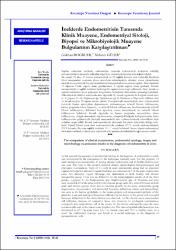İneklerde Endometritisin Tanısında Klinik Muayene, Endometriyal Sitoloji, Biyopsi ve Mikrobiyolojik Muayene Bulgularının Karşılaştırılması
Özet
Yapılan çalışmada ineklerde, endometritis tanısında endometriyal sitolojinin etkinliği, endometritislerin tamsmda kullanılan diğer bazı yöntemlede kıyaslanarak değe den dirildi.
Bu amaçla 13 akut, 17 kronik endometritisli ve 10 sağlıklı holstein inek kutlanıldı. İneklerin klinik muayeneleri, uterustan alınan örneklerin mikrobiyolojik ekimleri, uterus yıkantılannın sitolojik muayeneleri ile biyopsi örneklerinin histopatolojik muayeneleri yapıldı. Akut olgularda 13 olgunun 8’inde vaginal akıntı görülmezken, 5 olguda vaginal akıntı gözlendi. Kronik endometritisli ve sağlıklı ineklerde herhangi bir vaginal akıntı tespit edilemedi. Akut, kronik ve sağlıklı ineklerdeki rektal palpasyon bulgularının birbiderine benzerlikler gösterdiği belirlendi. Mikrobiyolojik ekimler sonrasında akut olgularda 10, kronik olgularda da 8 olguda olmak üze¬re A. pyogenes, E. coli, Streptococcus spp, Staphylococcus spp, K Pneumonia ve Maya izole edilirken akut ve kronik toplam 12 olguda üreme olmadı. Histopatolojik muayenelerde akut endometritisli ineklerde lamina epitelyaliste dejenerasyon, deskuamasyon, nötrofil lökosit infiltrasyonu, lamina propriada ödem, hiperemi, ve nötrofil lökosit infiltrasyonu, bez lumenlerinde nötrofil lökosit infiltrasyonu, dökülmüş bez epitelleri, utems lumenlerinde ise nötrofil lökosit infiltrasyonu belirlendi. Kronik olgularda ise lamina propriada; mononükleer hücre infiltrasyonu, değişik derecelerde bağ doku artışı, subepitelyal bölgede lenfoplazmositer hücre infiltrasyonları gözlemlendi. Sitolojik muayenelerde akut endometritislerde nötrofillerin fazla oldukları tespit edildi. Kronik endometritislerde dominant hücrelerin lenfosider olduğu belir¬lendi. Epitel/lökosit oranı akut endometritislerde ortalama 2.7/1, kronik endometritislerde 2.9/1 bulundu. Bu oran sağlıklı ineklerde 15/1 olarak belidendi. Sonuç olaraki endometriyal sitolojinin ineklerde endometritis teşhisinde saha şardarında kullanılabileceği kanısına varıldı. In this research the accuracy of endometrial cytology in the diagnosis of endometritis in cattle was investigated by the comparison of the techniques routinely used. For this purpose, 13 cattle having acute endometritis, 17 having chronic endometritis and 10 healthy holstein cow was used. The cows in this research recieved clinical, micobiological, histopathological and cytological examinations. Eight of 13 cattle in acute endometritis group had no abnormal vaginal discharge but abnormal vaginal discharge was observed on 5 of the acute endometritis cases. No abnormal vaginal discharge was determined in both healthy and chronic endometritis group. There was no difference on the rectal palpation results of all the three groups. A.pyogenes, E. coli, Streptococcus spp., Staphylococcus spp., K Pneumonia and yeast were isolated in 10 of the acute and 8 of the chronic group cattle. In a total of 12 cases in both acute and chronic groups, there was no bacterial growth. In the acute endometritis group degeneration, desquamation and neutrophyl leucocyte infiltration, edema and haemorrhage was seen in the lamina epithelialis, in the lamina propria and desquamated epithelia of the glandular tissue and neutrophyl leucocyte infiltration in the lumen of the glands and neutrophl leucocyte infiltration in the uterine lumen was observed. In the chronic cases; mononucleer cell infilration, increase of connective tissue was observed. In cytological examinations, neutophyls were predominant cell in the smears. In the chronic endometritis cases the most common cells seen in the smears were lymphocytes. The ratio of epitelial cells/leucocytes was determined as 2.7/1 in acute cases, 2.9/1 in chronic cases and 15/1 in healthy cases. As a result the endometrial cytology was found to a useful technique in the diagnosis of endometritis in cattle.
Kaynak
Kocatepe Veteriner DergisiCilt
3Sayı
1Bağlantı
http://hdl.handle.net/11630/2231Koleksiyonlar
- Cilt 3 : Sayı 1 [10]



















